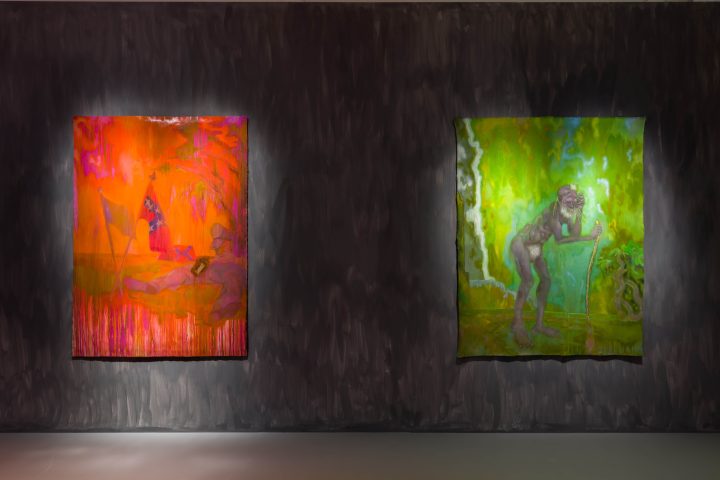
LONDON — What is curious about the works featured in New York-based artist Sedrick Chisom’s first UK solo show Twenty Thousand Years of Fire and Snow, at Pilar Corrias, is that while they are described as “sitting within the Afrofuturistic tradition,” there are no Black people present in them. This is not a criticism. It is an observation that provides an opportunity to consider what it means to create Afrofuturistic art — i.e., work that envisages futures from Black perspectives, and most commonly, imagines the lives of Black people in those futures — that does not require the presence of Black people.
In this particular apocalyptic future that Chisom so vividly builds, all people of color have left Earth. The remaining inhabitants are succumbing to a disease that affects skin pigmentation, and a contingent fortunate enough to be getting sick more slowly are attempting to assert dominance over a so-called “monstrous” race whom the pestilence has already ravaged and transformed entirely.
In Chisom’s characteristically long-titled artwork “The Fugitives of The Southern Cross Gathered With the Monstrous Races Beneath a Juniper Tree along the Outer Realm of the Savage South” (2021), the fugitive, perhaps a female figure, looks almost ethereal with lilacs, pinks, and whites conveying a sense of inherent, but also suspicious, magnanimity in contrast to the grotesque figures standing under the drooping canopy of a blackened juniper tree. One is headless; a face appears in its torso instead, evoking the mythological “Blemmyes” of Africa which were written about by ancient writers like Herodotus and Pliny the Elder. Chisom, himself an excellent mythmaker, draws on classical mythology, Christian iconography, and art historical and literary references as wide ranging as English illustrator Edmund Dulac and artist-writer David Batchelor’s Chromophobia.

The latter work discusses the idea that Western culture “fears corruption through color” and therefore reviles it. Chisom’s treatment of color is quite effective. His stark charcoal works such as “Medusa’s Covenant With The Lord of the Woods”(2020) — which depicts the eponymous figure mid-air and naked with white snake-like hair and sharp talon-like nails — take on a cartoon- or comic-like aura while simultaneously evoking William Blake. In other works, intense bright oranges and dirty lilacs, applied via oil and acrylic paints, spray paint, and watercolor, convey toxicity, intense heat, and an inhospitable environment.
There is also a sense of the indeterminate: a blurring of boundaries between day and night, between land, water, and sky, even between foreground and background. There’s a resistance to categorization that seems to speak to the absurdity of the war between the militant alt-right-inspired group in their Confederacy cosplay and the monstrous peoples, when thanks to the pestilence they share the same fate.

This idea is amplified in works like “The Wholly Avoidable Death of Mighty Whitey, The Last Drunk Dionysian Hero, AKA The Wholly Tragic Birth of Fragile Narcissus” (2020), in which a man sporting a look of incredulity, sees he has been stabbed with his own spear. “The Occidental Tower The Capitol Citadel of The Alt-Rightland was Naturally Situated Over a Lake of Fire”(2021) depicts a Tower of Babel-like structure that recalls both Bruegel the Elder and Verhaect’s paintings of the same subject. Chisom’s tower is a short, warped, almost deflated structure, a more pitiable sign of failed ambition. This is what Chisom does well: the use of the epic, grand mythological narrative to show up the degradation and desperation of a world that came to be ultimately because of anti-Blackness. Chisom depicts it as a world that is not just harsh, violent, and grotesque, but also utterly pathetic.
Sedrick Chisom: Twenty Thousand Years of Fire and Snow continues at
Pilar Corrias Eastcastle Street (54 Eastcastle Street, London) through August 20.
0 Commentaires